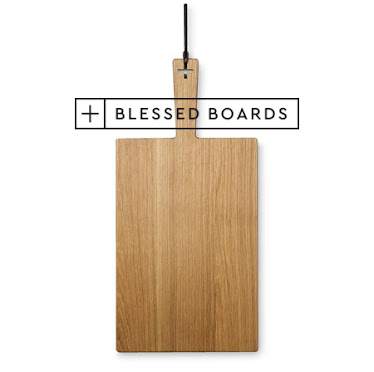Crossing My Ts and Dotting My...Lamp
String Light Nightlight | DIY

I'll get the current situation up with the room reveal but let's talk that lit star on the wall. In our rental, the kids had this big lamp on their dresser that was uber cool but also, uber heavy. It was great for awhile until they started thinking they could turn it on (the knob to turn it on was on the very top of the lamp and pretty much out of their reach) and started reaching and pulling the cantilever part down, down, down. Not my most kid-friendly piece of functional decor, that one.
Lamp Shade from Scratch
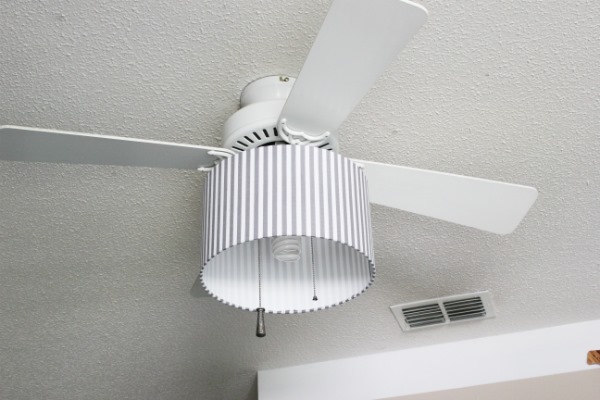
Lamp Shade Rings
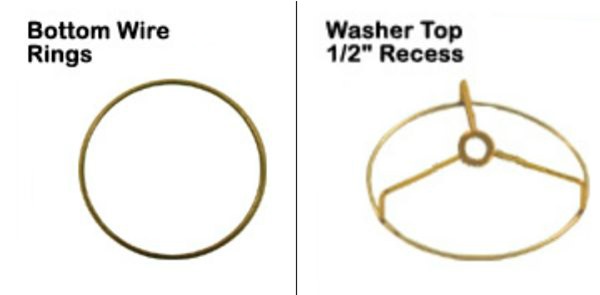

Fabric. If you want a shade that doesn’t inhibit light, you’ll want to cover it with a thin fabric. Quilting fabrics are great for this because they’re thin and you can find solids and lots of patterns. I went with a plain white broadcloth from JoAnn Fabrics for the kitchen shade. I like it because it’s really thin and resembles linen. You can sort of see the texture in the picture below. The pattern you can see through the broadcloth is my ironing board, so you can see just how thin this fabric is.

Scissors
Thin Marker or Pencil
Hot Glue Gun and Sticks
An Extra Pair of Hands
Ok. Once you have everything, you’ll need to cut your plastic to size (figure out the circumference using the above formula and add a half inch for overlap at the ends). Lay it out in an area large enough that you can lay the entire piece flat. (I locked myself in our room one day while Anthony was home so I didn’t have to play defense to keep the kids from walking all over it…bedroom workshop.)
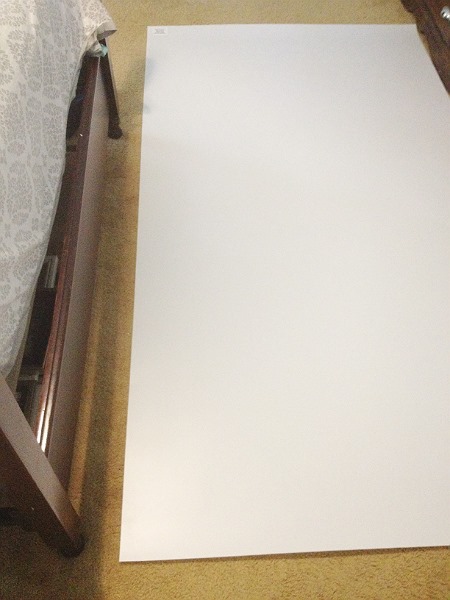
Then, draw the shade out. Assuming that one side of the plastic I purchased was straight, I lined up a quilting square and drew a straight line with a thin permanent marker along that side to the length I needed my shade to be. I wanted my shade to be nine inches high (up and down) and it needed to be 78 inches long to cover my rings and overlap at the ends.
 If you don’t have a quilting square, you can cut a piece of paper to your desired height, line it up along the straight edge of your plastic, and mark along the opposite side. If you’re using an old piece of existing plastic (the one you’re replacing the new plastic with) then obviously you’ll just have to trace. :)
If you don’t have a quilting square, you can cut a piece of paper to your desired height, line it up along the straight edge of your plastic, and mark along the opposite side. If you’re using an old piece of existing plastic (the one you’re replacing the new plastic with) then obviously you’ll just have to trace. :) Next, cut out your shade plastic.

(Side note: I made a lamp shade to cover our living room fan a couple of months ago and had some difficulty cutting the plastic. It wasn’t this new plastic sheeting I had but the old shade plastic that I was just shortening. Every time I cut, the plastic cracked at the tip of the scissors when it was closed completely. I’m not sure if that plastic was just old and brittle or if it was my scissors or what. So, this time around I didn’t close my scissors completely while I was cutting just to make sure that didn’t happen again. Make sense?)
So now that your plastic is set, covering it with fabric is up next.
The first thing you’ll probably want to do is give it a good ironing to make sure that no wrinkles pop up on your finished shade…because good luck ironing them out if that happens. ;)

After it’s nice and wrinkle-free, lay it out on a flat surface. I’d recommend covering your flat surface with an old sheet or tablecloth first though just to make sure you don’t get glue everywhere.
 As you can see, my fabric was a tad bit longer than my table so I just made sure to get the majority on.
As you can see, my fabric was a tad bit longer than my table so I just made sure to get the majority on. Next up, attached your fabric to the plastic with some spray glue. I used Duro All-Purpose spray glue (I think I got this at Walmart awhile back).
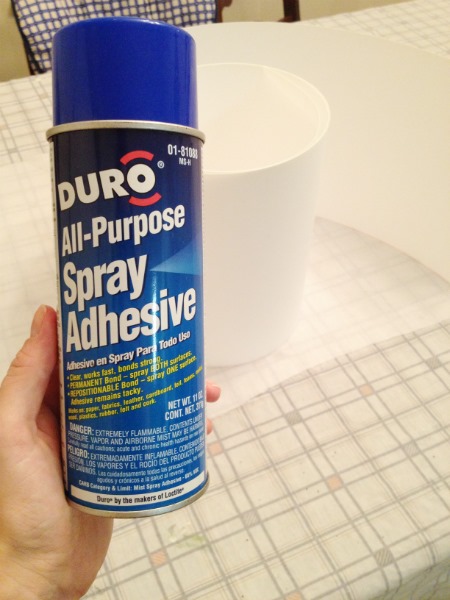 This stuff can get everywhere so make sure not to spray it around anything important. I went outside (at 10 ‘o clock at night) to the middle of the backyard, held up the plastic, and sprayed.) Make sure you spray the outside of the shade and not the inside. Let the glue dry for a minute or two for a better stick.
This stuff can get everywhere so make sure not to spray it around anything important. I went outside (at 10 ‘o clock at night) to the middle of the backyard, held up the plastic, and sprayed.) Make sure you spray the outside of the shade and not the inside. Let the glue dry for a minute or two for a better stick.Then, lay your plastic on top of your fabric. To make sure there aren’t any bubbles, it helps to start on one side and sort of roll the fabric on while running your hand down the plastic…if that makes sense.
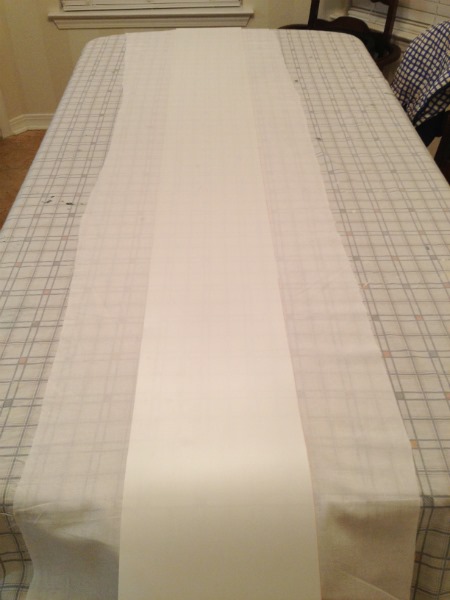
If you’re using a patterned fabric, make sure you lay the plastic on straight. If you lay it on and it’s not straight though, don’t fret. Just take it off and lay it on again. It really helps with this step and the following to have someone helping.
Once you have your plastic positioned where you want it, run your hands along the top of it, pressing so that every inch sticks.
Now, cut the extra fabric off. At the ends, you’ll want to leave anywhere from a quarter to a half inch to be folded over onto the plastic.
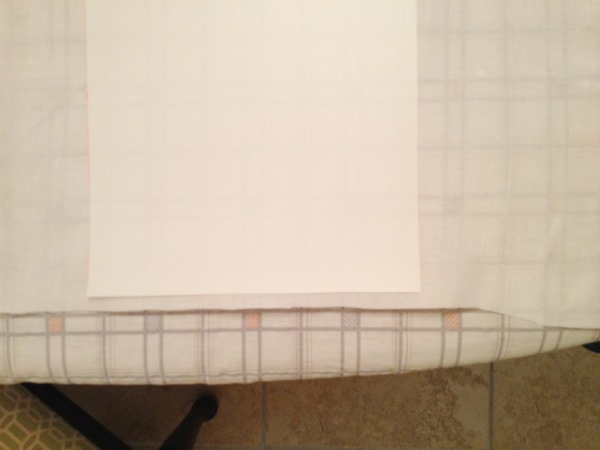
A good way to figure out how much to leave on the sides is to fold the fabric over the ring while it’s sitting on the very edge of the plastic (see pictures towards the end of the post). You’ll want to leave enough to completely cover the ring plus a few millimeters.
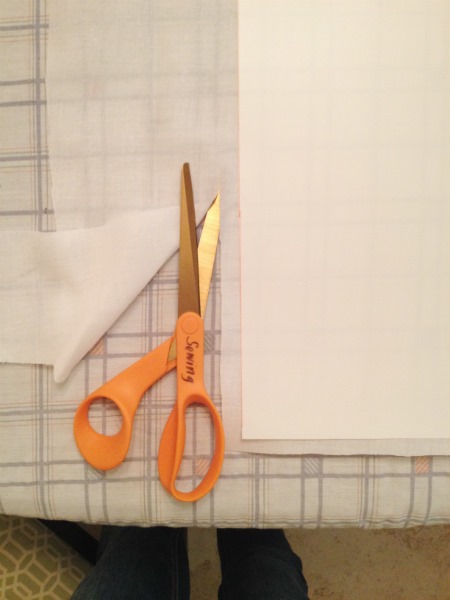

Make sure to cut a straight line. It doesn’t matter too much if it’s slightly thicker in some areas. You just don’t want any jagged edges you can get from cutting short snips. I was a little too hasty in spots thinking it wouldn’t matter and you can see those spots on the inside of my shade. Doh!

So, now it’s time to get out that glue gun. Make sure you grab a bunch of extra sticks too so that you don’t have to halt progress to run for some.

Hot glue is great in that it dries really quick but sometimes that’s the downfall too. And it’s messy. If there were such a glue that was thinner, room-temp, and dried quick, I’d be all over it. But, as far as I know, there isn’t, so hot glue it is.
First, glue both of your ends down. Just place a very thin line of glue along the very edge of your plastic, fold the fabric over, and press it down. The thinner your line of glue, the less bulky the ends will be.
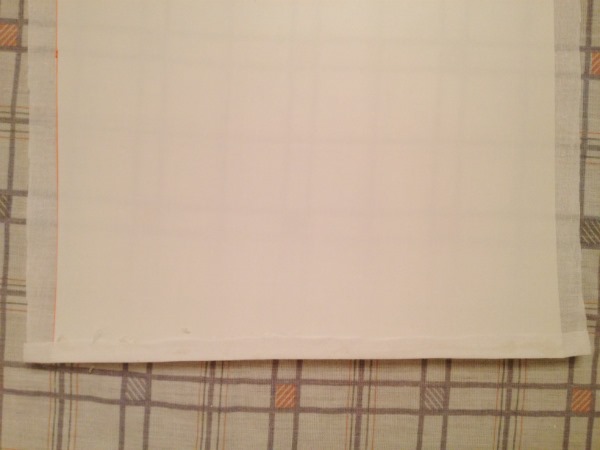
Next, grab both the top and bottom rings and place them directly over the ends and right at the very edge of the plastic. They shouldn’t be sitting on top of the fabric at all. Have someone hold them there for you. (Make sure that if your top ring has a recessed washer ring and bars, that the recess is going into the shade vs. outside or on top of it. I made that mistake with a recent shade and had to tear it apart and start over.)

It’s really important to take this next part slow. You’ll need to work in very small sections to ensure that you have no buckling/warping of the plastic on your shade. Run a line of glue along a couple of inches of one ring and quickly fold your fabric on top of and over the ring. Hold until it dries (a few seconds).

Don’t glue the plastic (made that mistake too). It makes for a cleaner finish if you just place glue on the ring because, as you fold the fabric over, you’ll push the glue into the crevice between the ring and plastic so it won’t be very noticeable in the end.
Glue a couple of inches on the top ring and then do the same couple of inches on the bottom ring. Over and over and over.

Meanwhile, your helper should be rolling the rings along so that whatever part your gluing is closest to the table. This will help make sure that the plastic is always touching the ring and protecting you from having a less than straight edge once you’re finished.
When you’re a few inches from the end, stop gluing. Roll your shade up so that the seam is visible. Run a thin line of glue along the end you started with and press the other end to it.
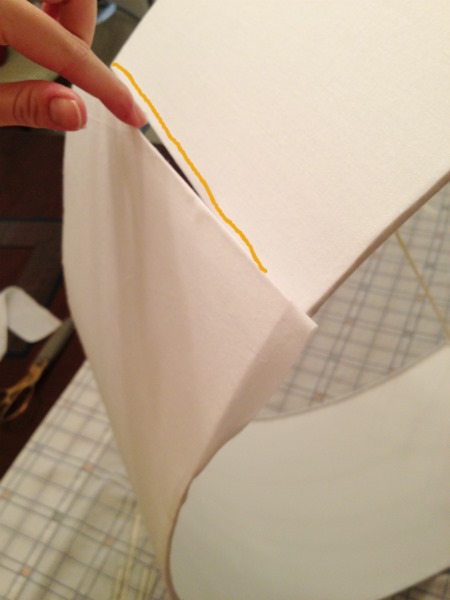
Last, finish gluing the rest of the shade where you left off in the same way that you glued before, little by little and with the part you’re gluing laying closest to the table.
I’ll go into more detail on the added stripes and how we attached this shade to the chandelier in another post but the washer at the top of this shade ring was a perfect fit over the threaded rod on the top of our chandelier so it just slipped right on.
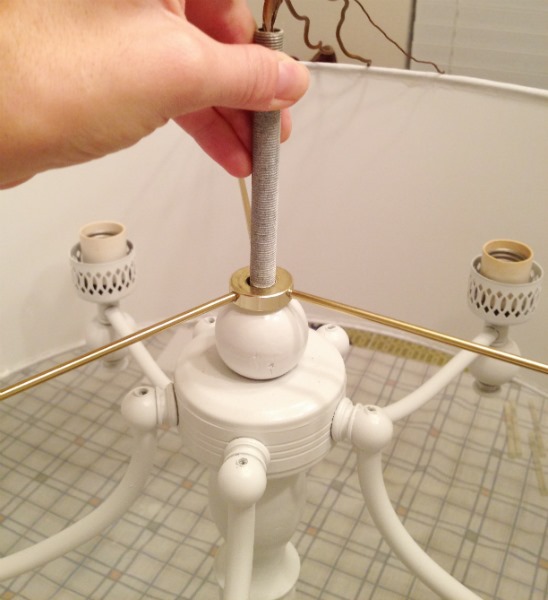
Until that other post, ciao! Thanks for letting me unload myself onto you through my fingers and a lengthy tutorial. Now, if someone will actually make a lamp shade and let me know how it goes, it’ll get me to 100% real quick like. :)
Hasta later.

Pom Poms + A Lamp Shade
Right before Sebastian was born, Anthony and I took a day-time date out to run some errands while our parents watched the twins. I’ve mentioned this before and usually it wouldn’t be worth mentioning at all except for the fact that, during that particular date we made a spontaneous stop at our favorite discount store, Dirt Cheap, where we were lucky enough to score two bargain buggies. You can read more about those here. Well, in one of those buggies was a stack of something like 22 lampshades, all originally from Target. They were all bedecked with the same floral pattern but were all brand, spanking new. I gave away most of them to family but kept three for a rainy day project. Yesterday was that day (even though it barely rained).
Here are two of the shades:
The third will make for another project another day.
The plan? To pimp these two out with some pom pom trim and sell them. I’d keep them but we have no place for them! Sad, I know!
Here’s how I did it and how you can too.
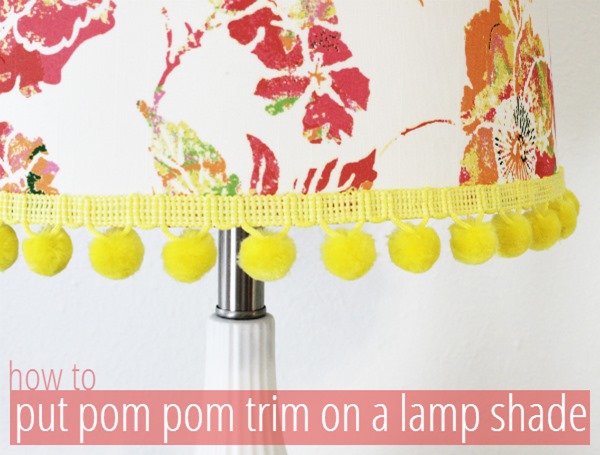
First, the supplies. You’ll need a scissors, a hot glue gun and sticks, some pom pom trim (I got mine on sale at JoAnn Fabrics), and a lamp shade. 
To figure out how much pom pom trim you’ll need, just slip a measuring tape around the base (or top if you’d prefer to do that!) and write that down.
To start, I took one end of my pom pom trim and glued it right over the vertical seam of the lampshade. You’ll want to make sure you start/end at this seam so that your ends aren’t noticeable when you’re finished. They’ll just be hanging out at the back of the lamp shade.

Then, working in small sections, I lined the base of the shade with a strip of hot glue and pressed the trim to the glue.
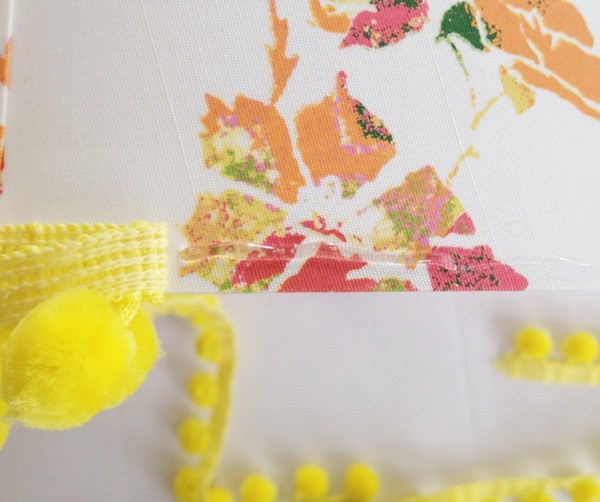
Working with hot glue is bittersweet because, while it gives instant gratification in that it dries super fast, you also have to be really careful when you’re using it because, if you don’t move fast enough, it could dry before you’re ready. That’s why working in small sections is key.
Also, I made sure to carefully line up the bottom of the trim with the bottom of the lamp shade. I wanted everything nice and straight and even.

One reason I saved this simple project for nap time was because I know I’d have had some swerving lines if I’d had distractions courtesy of my toddlers. ;) Joking but serious.
Once I reached the shade seam again, where I had started, I cut my trim past the last pom pom that overlapped the start of the trim. So, cut it past the last pom pom but right before the next pom pom so that you’ll have a pom pom plus a little of the trim at the end. (Sick of reading “pom pom” yet?)

Like this: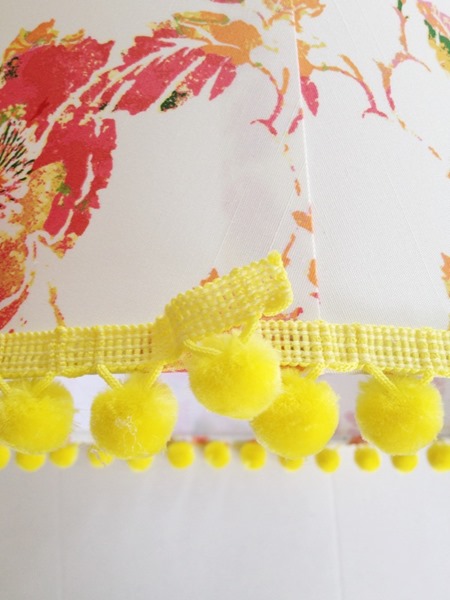
You don’t want to cut your trim so that it just meets the start because then you’ll be able to see the ends that could fray.
Once you’ve cut, add a dab of hot glue on that little bit of trim you have at the end and fold it over like this:
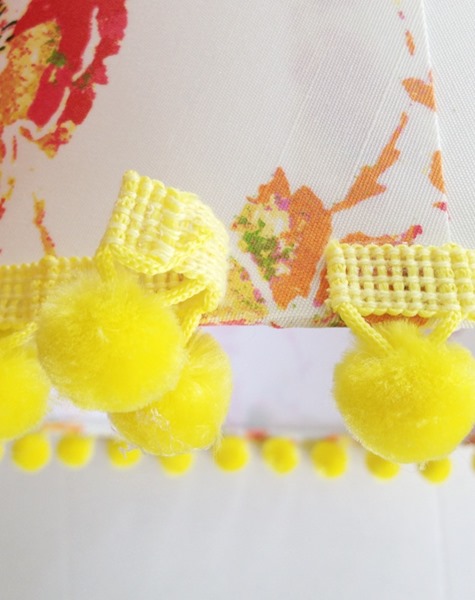
Now your edge will look finished and you can then just glue it right over the rest of the trim. 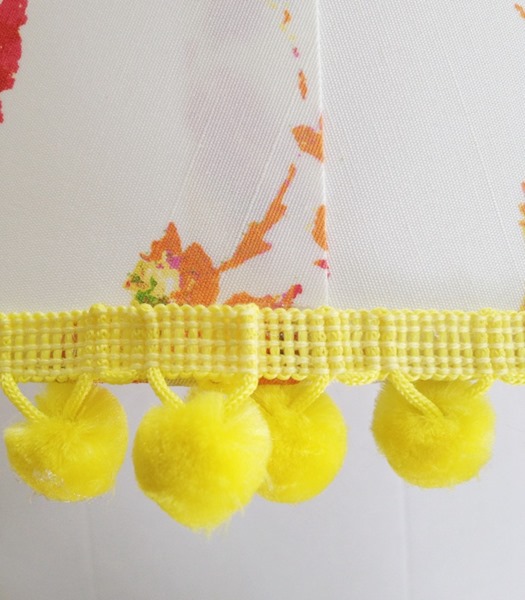
There might be a couple of pom poms closer to each other than the rest like on mine, but no one will notice since they’ll be at the back of the shade by the seam.
Ta-da!
I went back and forth between gluing the trim onto the outside vs. the inside of the bottom of the shade but in the end I went with the outside because the pom poms didn’t hang off their trim far enough to fully peek out from under the shade. But, either way would be great if you have the right trim! I also struggled with what color trim to go with but I won’t go into that because #firstworldproblems
With the leftover six inches of trim, I whipped up a little bracelet for the girls (whipped up meaning I hot glued the two ends together). They were overjoyed…probably more because their naps were over but hey.

I wish I’d have had enough for two but I guess I’ll use it as a lesson in sharing, which they (don’t) excel at at the moment. ;)
I’ve got another lampshade project up my sleeve that I’ll be sharing soon but until then, have you ever refashioned a lamp shade before? Do share! Thrift stores are usually stocked with them, making them an easy makeover target!
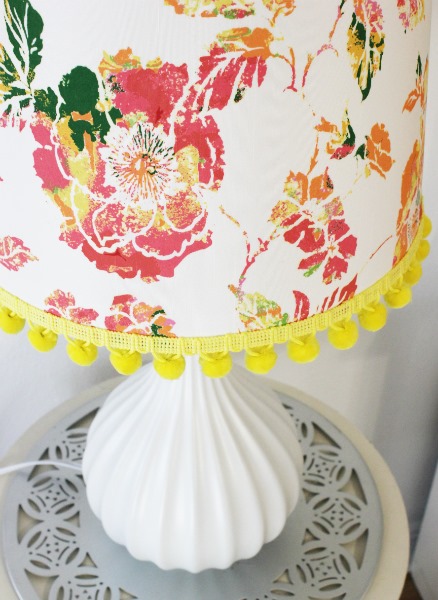
Happy humpday!
. . .
P.S. This isn’t my first time in the lamp shade arena. :) Check out these past lamp shade projects:
recovering a lamp shade with burlap
gussying up the girls’ lamp shade with crayon
adding a lamp shade to our master bedroom fan (a semi-fail)
adorning a shade with diy fabric flowers
Green With En-…Paint
I’ve been keeping my eyes peeled the past several months for some chunky new/old lamps at our local thrift stores to replace the tall, thin ones we have in our master bedroom. 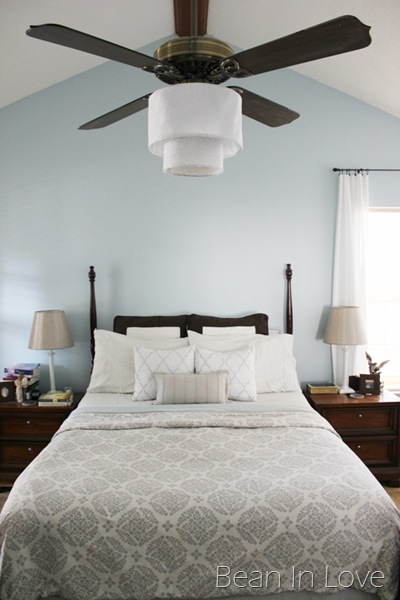
So many times I’ve found only one really cool lamp without a matching partner but a few weeks ago I lucked out and found these heavy, vintage glass lamps: 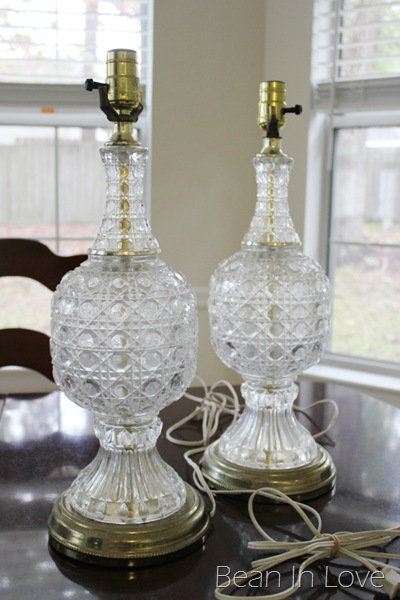
They were nice and dirty and in need of some tlc…just like I like ‘em.
Here’s what they look like today: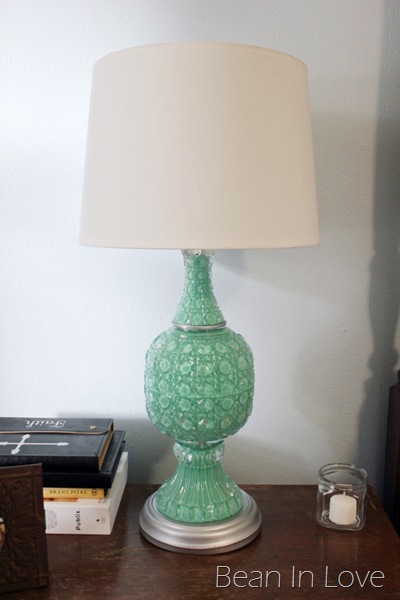
After taking apart and refurbing these lamps in the girls’ nursery, I knew a little of the how-to’s of wiring and taking apart/putting together lamps. It’s really not hard at all and so worth it if you find a sweet pair for cheap and in need of some paint or just new wiring.
Here’s how to do it. One lamp at a time; slow and steady does it. Turn the lamp over so you can see the base. You should see the end of the threaded rod and a nut holding everything in place. 
Unscrew the nut from the rod, which allows you to pull apart the lamp piece by piece. Be extra careful if you’re working with a glass lamp with lots of pieces like me. You’ll want to make sure the lamp is on it’s side and slowly start sliding each part down the rod just enough to loosen the whole thing up and get enough extra wiring at the top to remove the wiring from the light bulb base.
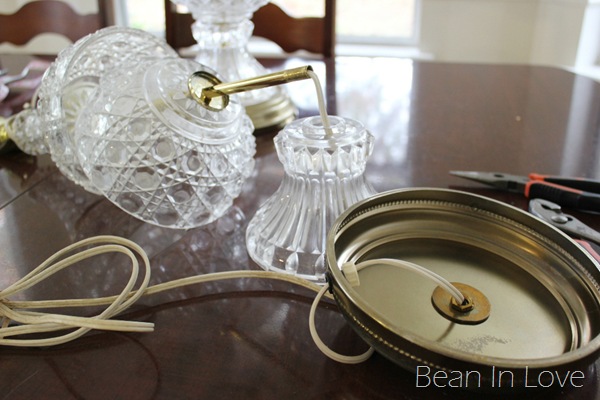
See what I mean by loosening everything up?
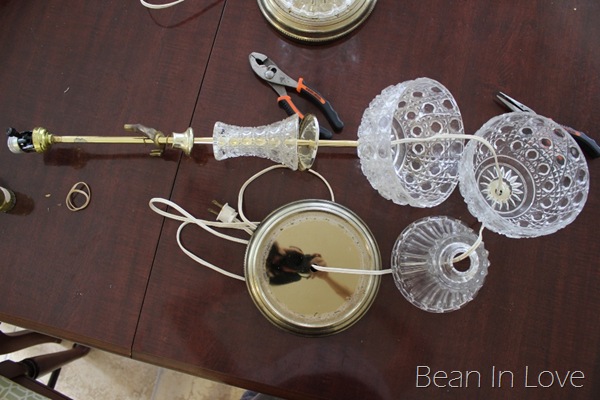
You won’t be able to remove all the pieces individually until you remove the wiring at the top of the lamp, which looks like this after you simply pull off the little top cover (sorry, no technical terms from the non-electrician over here).
Depending on how old or new your lamp is, this top part might look a little different. Some you simply unscrew and some you might have to remove a screw to separate. Mine simply pulled off.
Next you’ll want to remove your wiring. There should be two wires to remove (at least in the lamps I’ve messed with there were two) and those wires will be wrapped around two screws. Unscrew the screws which then loosens the wire and pull off the wire.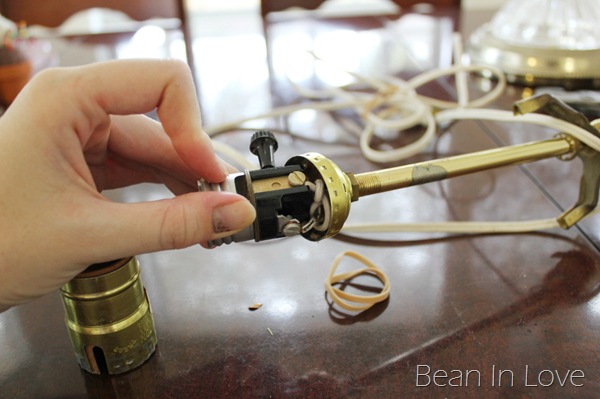

The light bulb casing will now be on it’s own and your wiring might be tied underneath it like this: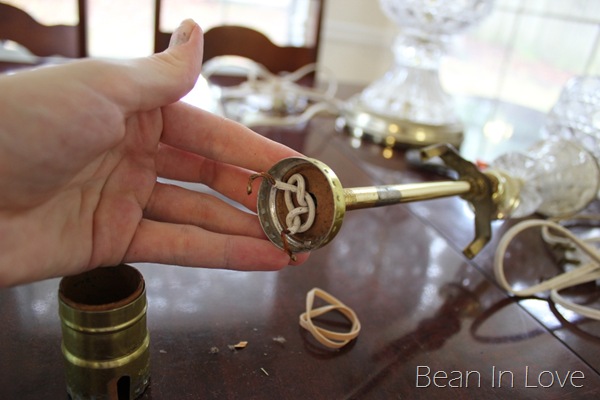
Untie it and now you can completely disassemble your lamp, piece by piece.
VERY IMPORTANT: Make sure that when you’re taking all the pieces off that you either take lots of pictures showing how they go back on to use as a reference later or take them off and line them up as you’re going and snap a shot. Unless you’re a master lamp maker, it’ll be hard to remember where each little piece goes! I lined all the pieces up and took a couple of pictures:
Now we get to the fun part. Painting. :)
The metal pieces of my lamps were peeling and discolored so at first I decided I’d spray paint them gold. So I did:
And then I changed my mind and spray painted them silver instead…fickle me.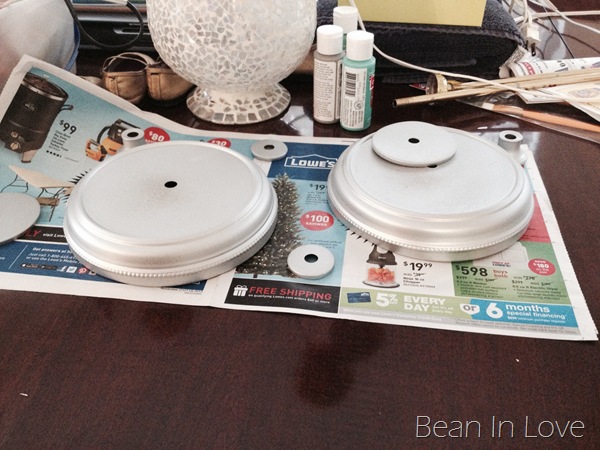
And then after I put the lamps back together I regretted the silver and wished I’d have kept them gold…fickle fickle me.
Whatever. Moving on.
I’ve had plans to inject some more color into our bedroom for some time now and thought the lamps would be a good place to start. So, the girls and I made a little trip to Michael’s to grab some acrylic paint and came home with this color: 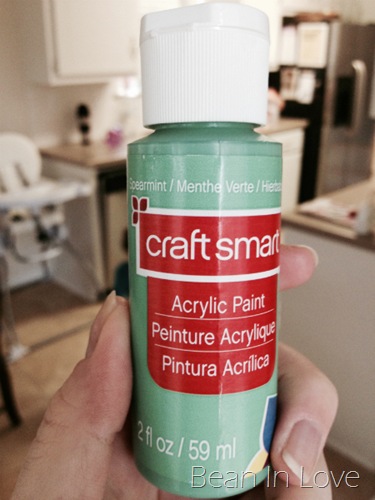
A minty green called Spearmint. (Side note: Is it just me or do you go into a craft/home improvement store on a mission to get paint knowing exactly what color you want, only when you get to the paint aisle you stand there dumbfounded because you thought you knew what you wanted but then you see the other shades of the color you thought you wanted and all the other colors and the other shades of every other color and all of a sudden you just don’t know what you want so you stand there looking like you got hit by a truck until you finally just grab a color hoping you won’t regret your decision (or you just leave thinking you’ll sleep on it another four nights)???? Whew, take a breather Sheena. Well, that’s me every. single. time. Fabric decisions and paint decisions. My life be like rough.)
So anyway, I got my paint and a little craft paintbrush and painted the inside of each glass piece (after washing them out nice and good-like). I gave each piece one coat and I know it looks a little streaky but the streakiness doesn’t show once the lamp is put together because no light illuminates through the glass, only from the top down…comprehendo?
I gave each piece one coat and I know it looks a little streaky but the streakiness doesn’t show once the lamp is put together because no light illuminates through the glass, only from the top down…comprehendo?
After the paint was dry I referenced the picture I took of all the lamp pieces lined up in a row and put the lamps back together, starting with the bottom-most piece and working my way to the top. If you’re working with painted glass pieces like me, be extra careful about scratching the paint. It will scratch off if scratched (one reason I wouldn’t recommend using acrylic paint on glass if you’re painting parts that will be touched once you’re finished). On the plus side though, if you change your mind about the color 10 months down the road, all you have to do is scrub and repaint. :)
Here’s an “unofficial” after picture showing the fabric for the pillows…
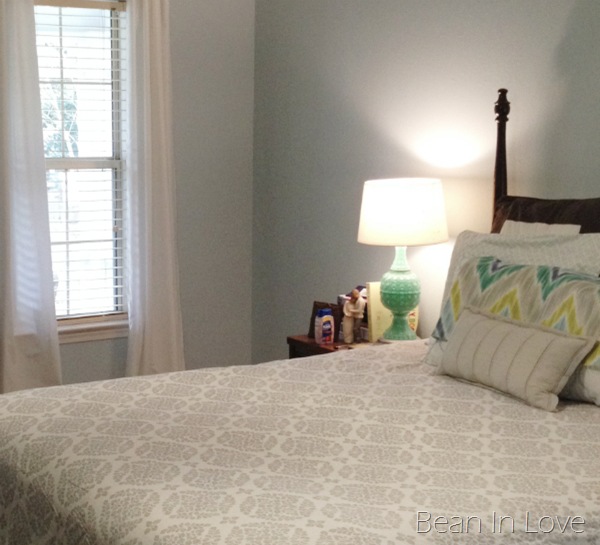
and the Tums I rely so heavily on every night set on a cluttered night stand. Plans include painting those nightstands (white?), adding some legs to raise them to bed level, and adding mirrors. :) I can’t wait. Other plans include building an upholstered headboard, hanging some much needed art around the place, and convincing Anthony we need some matching faux sheepskin rugs on each side of the bed. Then there’s always other ideas like hanging some faux roman shades under the curtains, maybe building a bench for the foot of the bed, yadda yadda yadda. All of this with three kids in tow. Should be done circa 2020. Am I asking too much if I say “stay tuned”? :)
Back to the project at hand though, here’s a budget break down:
Lamps: $12 ($6 each)
Shades: free (stolen from the guest bedroom whose lamps now sport some clearanced shades I found months ago)
Paint: 37 cents (from Michael’s and purchased with a 50% off coupon…because $.37 saved is $.37 earned people)
Spray Paint: already had (but purchased at Walmart for around $4 a can)
Total Cost: $12.37
What do you think? Isn’t the pattern on the glass the coolest? That’s what had me at hello…and cha-ching.

Funny, not-related story: As I was eyeing these lamps in the thrift store, an older gentleman eyeing some other second-hand item next to me looked over and with a serious face and twinkle in his eye said “You’d better pay for that basketball before you leave Miss.” (He was talking about the baby bump in case that one flew you by.) Usually I’m not one for comments on the belly (“Any day now, huh?”, “Looks like someone had too much to eat!”…), but that was cute, I had to admit. :)
Anywho, let me know if you have any questions or if I can explain anything better. I know the thought of taking apart a lamp can be intimidating but trust me, you can do it too!
Have a good Tuesday all you people!
. . .
P.S. If you already have your Christmas decor out and lit, you’re ages ahead of me…which I assume since Christmas is umpteen days away, you do. I was all excited to get ours out but the past few days have left me wondering if, on January 13th (the day Christmas officially ends, fyi) my future self will hate my past self for putting it all up so that I can take it all down while recovering from labor, nursing/caring for/changing/being attached to a newborn AND painfully chasing the twins. Is it worth it? Is singing Happy Birthday to Jesus enough for this year? I’m leaning toward yes…









